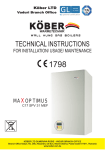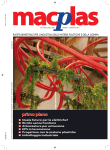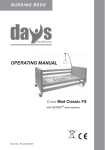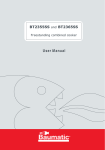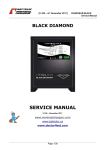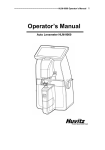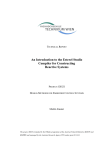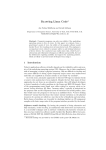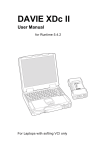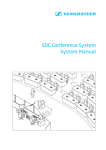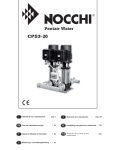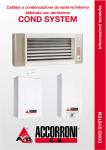Download Technical Manual
Transcript
Köber LTD Vaduri Branch Office TECHNICAL INSTRUCTIONS FOR INSTALLATION/ USAGE/ MAINTENANCE Type: C13SPV36MEF Type: C14SPV25MEF 1798 0086 KÖBER LTD DUMBRAVA ROSIE - VADURI BRANCH OFFICE Branch Office:Vaduri, No. 280, Alexandru cel Bun, Neamt District, Postal Code 617511, Romania Phone : +40.233.24.17.46, 233.24.19.33, Fax : +40.233.24.19.29 E-mail : [email protected], www.motan.ro KÖBER L.T.D. DUMBRAVA ROSIE - VADURI BRANCH implements and certifies the Quality Management System, according with standard EN ISO 9001:2008. This certificate assure the conformity of our products. The quality of our product is the result of permanent investments in implementing of the highest development and research technology, profesionalism, experiency and dedication of employers. The technical instruction must to be available any time. The technical instruction is the exclusive property of KÖBER LTD DUMBRAVA ROSIE, VADURI BRANCH It is forbidden to copy and to distribute the technical instruction in any other way without the prior written aproval of KÖBER LTD DUMBRAVA ROSIE, VADURI BRANCH TABLE OF CONTENTS: page 1. 1.1 1.2 1.3 2. BOILER SPECIFICATION 2.1 TECHNICAL DATA 2.2 MAIN COMPONENTS 2.2.1 BURNING SYSTEM (see picture no.1) 2.2.2 HYDRAULIC SYSTEM (see picture no.2) 2.2.3 CONTROL SYSTEM (see picture no.4) 3. 3 4 5 6 7 7 8 8 9 11 MOUNTING AND INSTALLATION INSTRUCTIONS ACCORDANCE WITH THE CURRENT REGULATIONS MOUNTING THE BOILER ON THE WALL CONECTING THE BOILER CONDENSATE DRAINAGE (see figure no.4) 12 12 13 13 19 PUTTING INTO SERVICE 20 COMMISSIONING VERIFY THE POWER SUPPLY TO THE BOILER THE FILLING UP CONNECT AN ROOM THERMOSTAT AND AN EXTERNAL PROBE VERIFY THE GAS TYPE THE MEASUREMENT OF STATIC PRESSURE THE MEASUREMENT OF DYNAMIC PRESSURE VERIFY THE EXHAUST SYSTEM INITIAL LIGHTING INSTRUCT THE USER 21 22 22 23 25 25 25 25 26 26 USAGE INSTRUCTIONS FOR THE END USER 6.1 CONTROL PANEL 6.1.1 BOILER CONTROL UNIT - POWER ON 6.1.2 “CENTRAL HEATING” MODE (symbol 8 ON) 6.1.3 “DOMESTIC HOT WATER - DHW” (symbol 7 ON) 6.1.4 SYSTEM WATER PRESSURE CHECKING 6.1.5 ADDITIONAL FACILITIES 6.1.6 THE BOILER SHUTTING-DOWN IN SAFETY CONDITIONS 6.2 FUNCTIONS CONCERNING BOILER SAFETY 6.3 ERRORS DETECTION 6.4 DELIVERY THE BOILER TO THE END USER AFTER INSTALLATION 27 27 30 31 31 31 31 32 32 33 34 3.1 3.2 3.3 3.4 4. 5. 5.1 5.2 5.3 5.4 5.5 5.6 5.7 5.8 5.9 6. DESCRIPTION OF THE APPLIANCE GENERAL DESCRIPTION BOILER MODELS GENERAL INSTRUCTIONS CONCERNING THE BOILER SAFETY TABLE OF CONTENTS: 6.5. ROUTINE SERVICING 6.6. STORAGE, MARKING, DOCUMENTS, PACKING, TRANSPORT 6.7 QUALITY AND GURANTEE CONDITIONS 6.8 RESPONSIBILITIES DURING THE WARRANTY PERIOD 7. APPENDIX: LISTS AND PLANS FOR MOUNTING AND INSTALLATION Plan 1 - The couplings arrangement Plan 2 - Hydraulic diagram Plan 3 - The couplings diagram for MKDens36 Plan 4 - The couplings diagram for MKDens25 Plan 5a, 5b - Typical flue system applications Plan 6 - Terminal clearances for flue installation Plan 7 - Lists and plans for mounting and installation Plan 8 - Electrical diagram 34 35 36 37 39 39 40 41 41 43 44 45 47 1. DESCRIPTION OF THE APPLIANCE SATEFY MEASURES PLEASE RESPECT STRINGENTLY THE INFORMATIONS OF TECHNICAL INSTRUCTION. OTHERWISE, CAN APPEAR FIRE AND BLOW UP RISK WHICH CAN LEAD AT MATERIAL PREJUDICE, PERSON'S INJURY OR EVEN DYING. VERY IMPORTANT! IT IS THE LAW THAT ALL GAS APPLIANCES ARE INSTALLED BY A COMPETEND PERSON. IT IS IN YOUR OWN INTEREST AND THAT OF SAFETY TO ENSURE THAT THE LAW IS COMPLIED WITH. DO NOT STORE OR USE FLAMMABLE MATERIALS IN THE VICINITY OF GAS BOILER. DO NOT USE THE GAS BOILER IF ANY OF HIS COMPONENTS HAVE BEEN FLOODED. INFORM URGENTLY THE SERVICE PEOPLE TO INSPECT THE GAS BOILER AND TO REPLACE THE FLOODED COMPONENTS. IN CASE YOU FEEL GAS FLAVOUR, RESPECT THE FOLLOWING OPERATIONS: - DON'T SWITCH ANY LIGHT OR FLAME - DON'T TOUCH ANY LIGHTING SWITCH - CALL URGENTLY THE GAS SUPPLIER. DON'T USE THE PHONE IN THE BUILDING WHERE IS INSTALLED THE GAS BOILER - IF YOU CAN'T CONNECT WITH THE GAS SUPPLIER, CALL THE FIRE BRIGADE. INSTALLING, COMMISSIONING, ROUTINE SERVICE WILL BE MADE ONLY BY QUALIFIED SERVICE ENGINEERS, QUALIFIED SERVICE CORPORATIONS OR BY GAS SUPPLIERS. THIS APPLIANCE IS NOT INTENDED FOR USE BY PERSONS (INCLUDING CHILDREN) WITH REDUCED PHYSICAL OR SENSORY CAPABILITIES, OR LACK OF EXPERIENCE AND KNOWLEDGE, UNLESS THEY HAVE BEEN GIVEN SUPERVISION BY A PERSON RESPONSABILE FOR THEIR SAFETY. 3 1.1 GENERAL DESCRIPTION The Motan MKDENS wall mounted gas boiler is a fuel gas consuming appliance, that has the role of turning the fuel gas power into thermal energy through burning. This appliance operates unsupervised due to its protection and control systems. The boiler consists of many components that are described in the following chapters. The gas enters inside the boiler through the gas supply circuit made of a coupling and a reducing valve, which must be set at 20 mbar for G20 H subgroup. After the reducing valve, the gas enters the gas valve and, further, the Venturi tube. The boiler is equipped with an air fan, which ensures the forced draught. The rotation speed of the fan is variable (control is made by modulation). In the pre-purge phase, the fan evacuates an air volume to provide a safe ignition. Otherwise, an explosive ignition might occur due to gas storage from non-operating periods. The air delivered by the fan enters the Venturi tube, where it draws in (by suction) and entrains the fuel gas supplied by the gas valve. The air and fuel gas are mixed in the Venturi tube diffuser. The resulted air gas mixture supplies the burner. The assembly fan gas valve Venturi tube ensures a constant and optimum air gas ratio at any load of the boiler. The flame ignition is performed by an ignition electrode, by means of an ignition transformer. During the combustion, the flame sensing is ensured by an ionization sensor. The main heat exchanger is made of stainless steel and has an annular shape. Inside this cylinder, the combustion chamber is placed. The main heat exchanger is designed to allow the heat transfer from the combustion gas to the water with minimal heat leakages. In case of the Central Heating (CH) circuit, the heat resulted from fuel gas burning is taken over by the main heat exchanger and sent to the water which is delivered by the circulating pump through the heating installation. When the flowmeter detects flow in the Domestic Hot Water (DHW) circuit, the three-way valve switches from the central heating circuit to the short circuit that includes the plate heat exchanger; in this case, the heat resulted from fuel gas burning is transferred to the domestic water. The system monitoring and control are electronically performed. The boiler setting is made from the control board (see the chapter concerning this subject). 4 1.2 BOILER MODELS Accesories Maximum Output TYPE DHW instant production [kcal/h] KW Fan Pump Expansion vessel C13SPV36MEF 30954 36 X X X X C14SPV25MEF 21496 25 X X X X MODEL NUMBER CODING C13, C14 S P V 36, 25 M E F - model code - with instant delivery of hot water (without external water tank) - with circulation pump - with sealed expansion vessel - maximum gross output in kW - continuous modulating air - gas supply system - electronic control and supervision of ignition and flame - forced draught Type: C13SPV36MEF Type: C14SPV25MEF 5 1.3 GENERAL INSTRUCTIONS CONCERNING THE BOILER SAFETY ! This manual is part of the product and must be given to the user. ! The commissioning and service operations is made only by authorized service engineers. ! Read this manual carefully and keep it carefully for a further application by the user and by the mounting and installing authorized personnel. ! The installation must be to the current Gas Safety (Installation and Use) Regulations and must be installed by a competent person. The installation, the putting into service, the service repair operations and the periodical technical checking are performed only by authorized personnel in accordance with the current standards and installation code. ! All the indications from this manual must be respected; any exception may cause damages and the manufacturer is not responsible for them. ! In case of a defective running of the device, shut it down and call up immediately one of the authorized breakdown services units . ! To guarantee the boiler efficiency and its correct operation it is recommended that the boiler be checked periodically by qualified personnel, complying with the manufacturer conditions. ! If the device is sold or given, make sure it is delivered with its technical handbook in order to be consulted by the new user/ installer. ! In case of some components damaging there will be used only the original components. You must have the manufacturer's permission to use some components from another company. You must obtain the written acceptance of the producer so that you may use those components. ! This boiler will be used properly. Any other use will be considered unsuitable. ! There is excluded any contractual or extra-contractual responsibility of the producer for the damages caused by the installing or usage errors and by the nonobservance of his instructions. ! It is compulsory to install a softener filter on the domestic water circuit, a mechanical impurities filter (Y filter) on the CH installation return and a pressure controller on the gas supply circuit. ! Not submitting to these technical manual regulations and to those from the warranty certificate leads to warranty loss. 6 2 BOILER SPECIFICATIONS 2.1 TECHNICAL DATA Commercial Name Type Gas category Draught type Combustion chamber Energy Efficiency Band (natural gas) MKDens 25 MKDens 36 C14SPV25MEF C13SPV36MEF I2H (20) I2H (20) Forced Forced Closed Closed A A Minimum CH net Heat input, Q 5 96.7% 106.7% 26.6 kW 5.2 kW 24.0 kW 4.7 kW 5 96.7% 106.5% 36.3 kW 8.1 kW 31.8 kW 7.3 kW Maximum DHW gross Heat input, Q 26.6 kW 36.4 kW Maximum DHW net Heat input, Q 24.0 kW 32.8 kW 24.3 kW 4.9 kW 24.5 kW 20 mbar 25 mbar 230V / 50 Hz 175 W 42 kg 1.75 l 2.65 Nmc/h 0.8 mc/h 0.8 si 3 bar 30 - 80°C 3/4” 1/2” 3/4” 32.3 kW 7.6 kW 33.3 kW 20 mbar 25 mbar 230V / 50 Hz 175 W 48 kg 2.45 l 3.58 Nmc/h 0.8 mc/h 0.8 si 3 bar 30 - 80°C 3/4” 1/2” 3/4” Nox class (natural gas) Net efficiency at rated output (natural gas) Net efficiency at 30% part-load (natural gas) Maximum CH gross Heat input, Q Minimum CH gross Heat input, Q Maximum CH net Heat input, Q Maximum CH heat output, P (at 100% load) Minimum CH heat output, P Maximum DHW output, P (at 100% load) Natural gas pressure on coupling (behind the reducer) Maximum inlet pressure Power supply Power consumption Weight Capacity of the heat exchanger Maximum gas rate (natural gas) Heating circuit - Flow rate Heating circuit - Min. and max admitted pressure Heating circuit - Outgoing water temperature Connections - inlet-outlet CH Connections - inlet-outlet DHW Connections - gas supply 7 Dimensions (mm) Depth Width Height With mounted elbow Expansion vessel Domestic Hot Water Temperature DHW flow rate t = 25°C t = 35°C t = 40°C Domestic cold water pressure Flue gases temperature Draught Concentric flue kit - diameters Twin flue kit - diameters Length of the concentric flue duct Lenght of the twin flue duct Guiding values Maximum water content in the installation 720 420 340 850 7l 30 - 60°C 720 420 383 850 8l 30 - 60°C 14.3 l/min 10.2 l/min 20.6 l/min 14.7 l/min 11.5 l/min 8 l/min 0.2 - 8bar 0.2 - 8bar 62 °C 62 °C 0.015 hPa 0.015 hPa D100 / D60 D100 / D60 D80 / D80 D80 / D80 3m (maximum) 3m (maximum) 4m (maximum) 4m (maximum) 150 l 200 l 2.2 MAIN COMPONENTS 2.2.1 BURNING SYSTEM (see picture no.1) It is designed to supply the necessary heat for CH and DHW circuits. It consists of the following elements: 1. Gas supply circuit. It must include a reducing valve that will set the inlet pressure at 20-25 mbar NG. It is compulsory to mount a pressure controller on the gas supply circuit. 2. Fan (position 1 picture 1). The boiler is equipped with an air fan (forced draught). The rotation speed of the fan is variable; its control is made by modulation. 3. Gas valve (position 2 picture 1). It is designed to ensure the gas supply at any load from the minimum load to the maximum load. 4. Venturi tube. It ensures the mixing of air and fuel gas: the air delivered by fan draws in (by suction) and entrains the fuel gas delivered by the gas valve; the air and fuel gas are mixed in the Venturi tube diffuser. The resulted air gas mixture supplies the burner. The assembly fan gas valve Venturi tube ensures a constant and optimum air gas ratio at any load of the boiler. 5. Burner. It is a PREMIX type, made of stainless steel and has a cylindrical shape. It operates on positive relative pressure. The burner output is controlled by means of a modulating fan. 8 6. Combustion chamber (position 4 picture1). It is sealed and has a cylindrical shape. It is placed inside the main heat exchanger (annular shaped). To reduce the heat leakages, both front and rear walls of the combustion chamber are isolated indoor with heat insulating material (ceramics fibers). On the front wall is placed the burner. 7. Air and flue gases ducts. According to the situation, can be concentric or eccentric type. In both cases, the air duct is connected to outside environment. The flue gases duct can be connected to the outside environment or to a chimney. 8. Condensate trap (position 5 picture1). It is specific to the condensing boilers and must be always filled with water (condensate). Otherwise, there is a danger that fumes might escape in to the room and cause poisoning. Picture no.1 2.2.2 HYDRAULIC SYSTEM (see picture no.2) Picture no.2 It consists of the primary circuit and the secondary circuit (DHW circuit). The primary circuit takes over the heat resulted from fuel gas burning and sends it to the heating installation or to the secondary circuit. The main components of the hydraulic system are: 1. Main heat exchanger (position 6 picture 2). Takes over the heat resulted from fuel gas burning and sends it to the water from the primary circuit. Is made of stainless steel and has an annular shape. Inside this cylinder, the combustion chamber is placed. 9 2. Circulating pump (position 7 picture 2). It is designed to supply the necessary water flow in the primary circuit in both modes Central Heating and Domestic Hot Water. Also, it must be aware of the hydraulic features of the pump, presented in the figure 1: HpH H [kPa] [m] 3 6 2 5 Pumping height 40 4 3 20 1 2 1 0 0 0.0 0.2 0.4 0.6 0.8 1.0 1.2 1.4 1.6 1.8 2.0 2.2 2.4 2.6 2.8 Q [m³/h] Pump water flow 3. Automatic air vent (position 8 picture 2). It ensures the air discharge from the primary circuit. It is mounted on the circulating pump shell. 4. Expansion vessel (position 9 picture 2). It allows the expansion of the hot water from the primary circuit. Thus, the hydraulic overstraining and/or damaging are avoided. 5. Safety valve. It limits the maximum water pressure in the primary circuit to 3 bar. If the water pressure increases over 3 bar, the safely valve opens automatically and primary circuit is drained. The safety valve closes when pressure drops under 3 bar. 4. Automatic by-pass. It allows the heat carrier recycling through the heat exchanger and pump, in case of pressure differences (between the external heat installation turn and return) at over 0.3 bar. 5. Filling system. It allows filling of the heating installation with water. It must be used when the system water pressure is too low. If the system water pressure decreases accidentally, the heating installation must be carefully checked before the filling procedure. 6. Three-way valve (position 11 picture 2). It allows routing of the thermal agent from the primary circuit towards the heating installation or the plate heat exchanger - according to the operating mode (CH or DHW). It is electrically controlled. 7. Plate heat exchanger. It takes over the heat carried by the water from the primary circuit and sends it to the domestic water from the secondary circuit. In this way, the domestic hot water is prepared. 10 2.2.3 CONTROL SYSTEM (see picture no.4) Is made by the following elements: 1. Boiler control unit (position 12 picture 4) It monitors and controls the operation of the boiler. 2. CH flow and return temperature probes (position 13 picture 4) Send temperature signals (CH flow and return) to the electronic board. In this way, instantaneous values of the temperatures can be displayed on LCD and the gas rate can be adjusted in order to deliver water at the set temperature. In addition, when CH flow and return probes indicate temperatures over admitted limits, malfunctions can be signaled. Picture no.3 3. DHW temperature probe (position 14 picture 4) It sends information about the temperature in the DHW circuit to the electronic board. Thus, the instantaneous value of the DHW temperature can be displayed and the gas rate is adjusted according to this information in order to deliver domestic hot water at the set temperature. 4. Overheating thermostat (position 15 picture 4) It cuts off the fuel gas supply when the maximum allowed temperature of the outgoing water is exceeded. In this situation, the boiler goes in lockout state; in order to exit the lockout state, the RESET key must be pressed. The thermostat is placed on the outgoing water pipe, close to the main heat exchanger. 5. Water pressure sensor (position 16 picture 4) It sends information about the water pressure from the heating system to the electronic board. In this way, the instantaneous value of the pressure can be displayed and the user can be notified in case of low water pressure. 6. Flowmeter (position 17 picture 4) It detects and measures the water flow in the DHW circuit. 7. Fan speed sensor It sends information about the fan rotation speed to the electronic board. This information allows optimization of the burning process at any load. 8. Ignition electrode (position 18 picture 4) It ensures the spark generation in the ignition stage. 9. Ionization electrode (position 19 picture 4) It provides information about the flame status, ensuring a safe combustion. When the flame is missing, the fuel gas supply is cut off and the boiler goes in the lockout state. 11 10. Flue gases temperature probe (position 20 picture 4) It cuts off the fuel gas supply when flue gases temperature exceeds 90°C. It is placed in the flue gases collector, which is located above the main heat exchanger. 11. External probe (optional) It ensures an optimum temperature of the water from the heating installation, when the external temperature is in the range -20...20°C. 12. Chrono-thermostat or room thermostat (optional) It keeps the room temperature at the user set value. It is provided on demand (optional). The control system achieves the following: ! Ignition control and flame drop out protection; ! Gas rate adjustment according to the user requirements regarding water temperature; ! Temperatures signaling for both CH and DHW circuits; ! System water pressure signaling; ! Protection against fuel gas cut offs; ! Protection against overheating of the heating circuit; ! Protection against excessive water pressure; ! Protection against water loss in the primary circuit; ! Protection against clogging of the condensate drain system. 3. MOUNTING AND INSTALLATION INSTRUCTIONS This chapter addresses both to the qualified personnel that performs the boiler installation and to the beneficiary that is concerned that the mounting and installation of the boiler are performed following the safety rules in operation of all the installations which contribute to the good running of the boiler. THE BOILER INSTALLATION IS NOT THE SAME WITH THE BOILER STARTING. THE BOILER STARTING MUST BE DONE BY QUALIFIED PERSONNEL AND AUTHORIZED IN ACCORDANCE WITH THE CURRENT LEGISLATION. THERE IS NO GUARANTEE WITHOUT THE AUTHORIZED PERSONNEL SIGNING THE PUTTING INTO SERVICE STATEMENT, AND THE COMPANY WITHDRAWS ANY BOILER GUARANTEE OR RUNNING RESPONSIBILITIES. 3.1 ACCORDANCE WITH THE CURRENT REGULATIONS The EC type examination certificates eliberated for this types of combi boilers, by official and autorized bodies, shows the accordance of the appliance with the current regulations and gives the presumption of the conformity with the Gas Appliances Directive, Low Voltage Directive and Electromagnetical Directive. 12 3.2 MOUNTING THE BOILER ON THE WALL The boiler is designed to be use in integrated in heating systems in closed chambers. It is forbidden to mount the boiler outside the building. The appliance has the protection level IP 40; ATTENTION! Improper climate conditions of installing the boiler automaticcaly conduct to warranty lose. It shall be performed only if all the conditions concerning the connection of the boiler are respected (see the chapter 3.3 “Connecting the boiler”). · - Remove the packing. · - Make two holes on the wall, at a desired height, by using the pattern drawn on the boiler pack. · - Fix the two dowels on the wall and then mount the two hooks by screwing up. The dowels and hooks are provided with the boiler. · - Fix the boiler on the wall by inserting the hooks into the two holes made on the posterior side of the boiler. - Check the stiffness of the boiler fixed on the wall, to be sure that the structure of boiler is not stressed 3.3 CONNECTING THE BOILER Connecting the boiler to the electric power supply, water, gas, heating installations and air / flue gases ducts can be performed only by authorized personnel for mounting / installing activities. ELECTRICAL PROCEDURES Electric power supply THE CONNECTION TO THE ELECTRIC NETWORK MUST BE ACCOMPLISHED ACCORDING TO THE CURRENT LEGISLATION AND STANDARDS. The boiler must be connected to a mono-phase network of 230V / 50Hz with ground protection, through a 5A fusible plug. The color semantics will be as follows: brown= phase, blue=null, green/yellow=earth. Insert the plug into connection, so that the phase of the network to correspond to the brown wire of the supply cable. The correct polarity of the supply connection can be identified by using a multimeter.. IT IS FORBIDDEN TO INSTALL THE BOILER WITHOUT EARTH CONNECTION . ONLY THE MANUFACTURER OR THE AUTHORIZED PERSONNEL CAN REPLACE THE ELECTRICAL POWER SUPPLY CABLE IF DAMAGED. 13 The connection of the boiler to the electric power supply of the building must allow a complete isolation of the boiler in case an intervention must be performed, except the disconnection of the ground. The external connections must be in accordance with the current regulations. IN CASE OF MOUNTING THE ELECTRICAL WIRES BY THE SERVICE DEPARTMENT PERSONNEL, THE INSTRUCTIONS WILL BE RESPECTED, IN ORDER TO NOT EXCEED THE MAXIMUM TEMPERATURE. Routing of the electrical wires The wires entering into the command box are connected to BCU through connectors (see Plan 7). The wires pass into the command box through rubber rings. For a good sealing and insulation protection the wires enter the pressurized chamber of the boiler through silicone rubber rings. The wires connection to the execution elements is made in conformity with Plan 6. Command box installation The command box is mounted on the connections plate. On the right side the commnad box is dirrectly fixed into the plate. On the left side a screw passing a sleeve fixes the commnad box in the case. GAS SUPPLY The gas supply must be done in accordance with the current standards. The gas coupling must have 3/4" in dimension. The pipe diameter of the gas installation must have at least the same or greater diameter as the coupling diameter (3/4"). After the boiler is coupled to the gas network, the gas installation tightness must be verified according to specific procedures. The minimum/maximum inlet pressure in the gas valve must have the following values: - using natural gas: 20 / 25 mbar THE MAXIMUM PRESSURE ALLOWED FOR THE GAS VALVE IS 60 MBAR. IF THE PRESSURE VALUE IS ABOVE THE PRESCRIBED LIMIT, NOISES CAN APPEAR CAUSED BY TURBULENT BURNING. ALSO, THE COMBUSTION PERFORMANCES CAN BE ALTERED DUE TO GAS VALVE MALFUNCTION. IT IS MANDATORY TO INSTALL A PRESSURE CONTROLLER WITH IMPURITY FILTER AND TO COMPLY WITH THE RULES REGARDING THE MINIMUM COUPLING SECTION DIMENSION. 14 THE PRIMARY SYSTEM (HEATING) The boiler is connected to the heating installation by using the A and E couplings (see plan 2). The maximum working pressure is 3 bar. The installation radiators for the condensing boilers must be sized with at lest 6% greather than conventional boilers (where the turn/return temperature difference is 200C). This heating system is recommended in order to obtain the maximum efficiency of the condensing boiler. The heating system will be designed by the qualified and authorized personnel according to national codes, in the mounting/installing activities, and the standards for the designing and execution the heating systems and which execute these activities, so that the installation can be used in best conditions. It is important to pay attention to the pipes dimensions, head losses and heating elements while designing the heating system. Also, it must be aware of the hydraulic features of the pump, presented to chapter 2.2.2 “Hydraulic system” figure no.1. The boiler is designed for use in a sealed central heating system. It's forbidden the mounting of gas boiler outside the building. For central heating system characteristics, please follow chapter 2.1. Before commissioning, authorized service engineers have to verify the central heating system. Must be eliminated all the fact which can influence the good operation of central heating system. On the outlet of central heating system is obligatory the mounting of an impurity filter. THE FILLING UP It is reccomended that the installation filling up to be done with softened water. Note: The primary system is filled up with water until the pressure achieves 1.5 bar +/- 0.5. Heating the water leads to thermal dilatation and pressure modification. Filling up the instalation requires to follow next steps: First, open the domestic hotwater tap and then the central heating tap Fill up the heating system ultil the requested pressure is achieved Verify the tightiness of the entire system by cecking for potential leakages and solve eventual problems; after this, repeat the steps presented above The airing of the system is acheived using deairators from instalation and using boiler pump airing plug by repetitive starting the pump with gas valve closed. After these operations, the system is filled up again until the nominal pressure is acheived. The instalation pressure is verifyed. 15 IT IS MANDATORY TO INSTALL A MECHANICAL IMPURITIES FILTER ON THE PRIMARY HEATING SYSTEM (RETURN). IT IS FORBIDDEN TO USE AN EMPTY BOILER OR A BOILER PARTIALLY FILLED WITH WATER. USING AN EMPTY BOILER OR A BOILER PARTIALLY FILLED WITH WATER MAY LEAD TO EXPLOSIONS. THE DRAINING PROCEDURE The draining points must be placed in accessible locations. The minimum recommended diameter of the draining pipes is 1/2”. SECONDARY CIRCUIT (DOMESTIC HOT WATER) The boiler is connected to the heating installation through B and D couplings (see plan 2). Domestic water pressure must be 1 bar minimum. IT IS COMPULSORY TO INSTALL A SOFTENER FILTER AND A MECHANICAL IMPURITIES FILTER ON THE DOMESTIC WATER CIRCUIT. IN ORDER TO TAKE OVER THE EXPANSIONS FROM THE DOMESTIC WATER CIRCUIT THE SUPPLY PIPE MUST ALWAYS REMAIN OPEN (ONLY TAPS FROM DRAINING POINTS MUST BE USED FOR CLOSING THE WATER SUPPLY). AIR SUPPLY EXHAUST BURNING GAS The gas boiler doesn't require any air vents in the room where is installed or in neighbourhood rooms. The air supply for a efficient burning is made directly from outside. The complete gas boilers package contains the air supply - exhaust burning gas system - named flue system. In standard package, the gas boiler contains coaxial flue system. At request, we can supply dual flue system. Additional flue components are available as follows: additional flue duct 1 m, additional flue duct 1/2m, additional elbow 90. These are not supplied with the standard package of coaxial flue system and can be delivered at request. The mounting of flue system is made according with explainings, and examples of mounting you can find in Plane no. 5a, b and terminal clearances for flue installation see in Plane no.6. For C43 and C83 flue type please see details in plan no.7. Flue gases duct and air duct are supplied with the boiler can be concentric or twin type. In the case of the concentric kit, the diameters are: 60mm for flue gases duct and 100mm for air duct. In the case of the twin flue, both ducts are 80mm in diameter. 16 IN CASE OF CONCENTRIC FLUS, AIR AND FLUE GASES DUCTS MUST HAVE MAXIMUM 3m IN LENGTH (WITHOUT THE FIRST ELBOW). IN CASE OF TWIN FLUE, AIR AND FLUE GASES DUCTS MUST HAVE MAXIMUM 4m LENGTH (WITHOUT THE FIRST ELBOW). CONCENTRIC FLUE SYSTEM (figure 2) Consist of an elbow, the flue gases duct, the air duct and afferent gaskets. The coupling is peformed as follows: - All gaskets are mounted in their proper places - The elbow is fastened on the upper cover of the pressurized chamber using 4 screws, ensuring the gasket between elbow and cover is properly placed - The duct is then fastened in the elbow. The coaxial ducts must pass through the wall using a pipe with an inner diameter of 120mm. This pipe is fastened inside the wall and its length must be established according to the wall thickness. The gaskets between wall and ducts are mounted at the both ends of the passing pipe. Figure no. 2 Components: 2 screw M5X25 3, 7, 8 - rubber gasket 4 plastic flange 5 screw 3,9x19mm 6 - flue elbow 900 9 - air duct 100mm/3.93 in - flue duct 60mm/2,36 in 10, 11 - ornamental wall gaskets 17 IT IS COMPULSORY FOR THE AIR AND FLUE GASES DUCTS TO HAVE AN ASCENDING SLOPE OF 3% (APPROXIMATELY 2°) IN ORDER TO FORCE THE CONDENSATE TO FLOW BACK TOWARD THE COMBUSTION CHAMBER. A 90 degree flue elbow reduces the total duct length by 0,5 m. Under no circumstances the flue length (including allowances for extra bends) must not exceed 3m. TWIN FLUE SYSTEM (figure 3) Consist of two exhausting ducts of Ø80mm in diameter and two elbows (for air duct and for flue gases duct) and the afferent gaskets. - All gaskets are mounted in their proper places. - The elbows are fastened on the upper cover of the pressurized chamber using 4 screws, ensuring the gasket between elbow and cover is properly placed. - The ducts are then fastened in the elbows. - The air and flue gases ducts must pass through the wall using pipes with an inner diameter of 80mm. 18 Figure no. 3 1, 10 - gasket 2, 9 - flue duct adaptor Ø80 0 5 - flue elbow 90 Ø80 mm/ 3,15 in 4 plastic terminal Ø80 mm/ 3,15 in 6 - air and flue duct Ø80mm/3,15 in 7 - wall ornament gasket 3 - screws 3,9X9,5mm IT IS COMPULSORY FOR THE AIR AND FLUE GASES DUCTS TO HAVE A SLOPE OF 3% (APPROXIMATELY 2°) DESCENDING, RESPECTIVELY ASCENDING. A 900 FLUE ELBOW REDUCES THE TOTAL DUCT LENGTH BY 0,5m. UNDER NO CIRCUMSTANCES MUST THE LENGTH (INCLUDING ALLOWANCES FOR EXTRA BENDS) EXCEED 5m. 3.4 CONDENSATE DRAINAGE - see figure 4 The condensate resulted from the water contained in the burning gases is drained through a pipe specially designed for this purpose. The condensate must not be drained unless a neutralization process is performed, because the condensate is acid (with a typical pH in the range 3.8 ÷ 5.4). The materials used in the construction of the primary heat exchanger and flue duct system cannot be the same as those used in conventional boilers (i.e. cooper or aluminum) because of the acidity of the condensate. Therefore, the primary heat exchanger is made of stainless steel and the flue ducts are made of special plastic materials. At boiler installation, half liter of water must be introduced into the flue duct in order to fill the condensate trap. This eliminates the danger that fumes might escape through the flue duct into the room and cause poisoning. In order to avoid water stagnation inside the condensate drainage system, the pipes must be continuously descending, especially if the drainage system might be exposed to freezing. The condensate drainage must comply with the current standards and installation codes available in the destination country. Condensate drain hose mounting instructions (see figure 4): - unscrew the nut - replace existing hose with another PVC flexibile hose, with desire length - mount the gasket on hose - screw in the nut together with hose and gasket. Condensate siphone Drain valve Gasket Nut Condensate siphone PVC hose, Dext.=25mm Condensate siphone Drain valve Figure no.4 Condensate drain 19 4. PUTTING INTO SERVICE 1. The putting into service shall be performed only by an authorized personnel. 2. The personnel that ensure putting into service shall agree with the conditions specified in the Technical Manual. These are necessary for warranty awarding: The boiler must be correctly installed (conforming to local laws) and the proper draught must be ensured. The electrical power supply must be compliant with the next parameters: 230V, 50Hz and 130W minimum. The gas supply system must be built by authorized personnel conforming to local laws. The CH and DHW installation must be built by authorized personnel. The minimum distance to the nearest draining point is 6m. The putting into service shall be performed only by personnel authorized and certified by KOBER LTD Turturesti, Vaduri Branch. The authorized personnel may decline the responsibility if the conditions stated above are not met. 3. The conditions stated above are compulsory. The authorized personnel shall specify all malfunctions that obstruct the proper operation according to the parameters indicated in the Technical Manual. The boiler will start only if all elements are optimally functioning. The non-compliance with these conditions obstructs the putting into service at the established date. In this case, the end-user will pay all taxes to the authorized personnel for putting into service. The putting into service and maintenance of the “MOTAN” boilers during the warranty period must be performed only by personnel authorized (according to local laws) and certified by KOBER LTD Turturesti, Vaduri Branch. It is compulsory to perform the following checks: 1. The boiler must be placed in areas with ventilation according to the current standards regarding boilers mounting and putting into service. 2. The heating installation must be completely filled with water and correctly vented; the water pressure must be of minimum 1 bar. 3. The gas supply system must be equipped with a pressure controller that ensures constant pressure / constant gas rate in accordance with the specifications from the Technical Manual. Check the gas supply system (especially the joints) for leakages. 4. The gas consumption and maximum / minimum pressures on gas valve inlet and outlet must be adjusted in accordance to the Technical Manual. 5. The electrical power system must be compliant with the parameters specified in the Technical Manual. 20 5. COMMISSIONING 1. The commissioning shall be performed only by an authorized personnel and certified by KOBER LTD Turturesti, Vaduri Branch. 2. The personnel that ensure commissioning shall agree with the conditions specified in the Technical Manual. These are necessary for warranty awarding: a. The boiler must be correctly installed (conforming to local laws) and the proper draught must be ensured. b. The electrical power supply must be compliant with the next parameters: 230V, 50Hz and 130W minimum. c. The gas supply system must be built by authorized personnel conforming to local laws. d. The CH and DHW installation must be built by authorized personnel. The minimum distance to the nearest draining point is 6m. e. The commissioning shall be performed only by personnel authorized. f. The authorized personnel may decline the responsibility if the conditions stated above are not met. 3. The conditions stated above are compulsory. The authorized personnel shall specify all malfunctions that obstruct the proper operation according to the parameters indicated in the Technical Manual or Service Manual. The boiler will start only if all elements are optimally functioning. The non-compliance with these conditions obstructs the putting into service at the established date. In this case, the end-user will pay all taxes to the authorized personnel for putting into service. The commissioning and maintenance of the “MOTAN” boilers during the warranty period must be performed only by personnel authorized (according to local laws) and certified by KOBER LTD Turturesti, Vaduri Branch. The steps of commissioning 1. 2. 3. 4. 5. 6. 7. 8. 9. provide power supply to the boiler fill the central heating system connect the room thermostat and external probe verify the gas type measure the static pressure measure the dynamic pressure initial lighting testing heating system instruct the user 21 5.1 VERIFY THE POWER SUPPLY TO THE BOILER Verify with a multimeter: the polarity, the grounding, grounding and short circuit resistance. The gas boiler must be connected at monophase network by 230V/50Hz through 5A fast-blowing fuse, with grounding. The electrical supply must be grounded and must keep into accout the semantic of colour: brown phase; blue null, green yellow = grounding. Connect double-pole switch in plug, taking care that the phase to correspond with brown wiring of power supply cable. 5.2 THE FILLING UP It is reccomended that the installation filling up to be done with softened water. Note: The primary system is filled up with water until the pressure achieves 1.5 bar +/- 0.5, 21,49+/-7,1 p.s.i. The water heating bring to at thermal distension which modify the pressure. Appliance with Filling Tap Filling up the instalation requires to follow next steps: · First, open the domestic hotwater tap and then the central heating tap. · Fill up the heating system ultil the requested pressure is achieved. · Verify the tightiness of the entire system by cecking for potential leakages and solve eventual problems; after this, repeat the steps presented above. · The airing of the system is acheived using deairators from instalation and using boiler pump airing plug by repetitive starting the pump with gas valve closed. After these operations, the system is filled up again until the nominal pressure is acheived. · The instalation pressure is verifyed. IT IS MANDATORY TO INSTALL AN IMPURITY FILTER ON THE PRIMARY HEATING SYSTEM (RETURN). IT IS FORBIDDEN TO USE AN EMPTY BOILER OR A BOILER PARTIALLY FILLED WITH WATER . USING AN EMPTY BOILER OR A BOILER PARTIALLY FILLED WITH WATER MAY LEAD TO EXPLOSIONS. 22 5.3 CONNECT AN ROOM THERMOSTAT AND AN EXTERNAL PROBE ROOM THERMOSTAT The fitting of a room thermostat is made on one of inside walls. Don't mount near heat sources, in front of sun, near cold water pipework/ hot water pipework or near places with air current. Room thermostat and external probe is used for optimize the electrical and natural gas consumption and for a superior comfort. Ensure the following operations are carried out: - dismantle the boiler's frontal panel; - unscrew the screw securing the lid and open up on hinges for making the coupling; - identify the room thermostat' s coupling connector (bridge wiring) and the external probe's coupling connector (black wiring); Picture no.5 - in case of room thermostat, take off the connection electrical cable (the bridge) between the two connector's terminals; - uninsulate the two wiring of bifilar cable which make the connection with room thermostat or external probe; - Introduce the bifilar cable in the connectors through screwing; - The bifilar cable's diameter is 0,5 mm2 and is from copper litz wire. The placing of room thermostat is made as so to assure a maximum comfort. We recommend to place the room thermostat at a height of 1,2 m, in the coldest room. EXTERNAL PROBE By using an external probe, the “climatic compensation” function may be activated (only be the autorized service person). In this case, the outgoing water temperature is adjusted according to the outside climatic conditions, ensuring a high comfort and energy saving when boiler operates in “Winter” season (AT mode). Thus, on outside temperature increase, the outgoing water temperature is decreased according to a “compensation curve” (see figure 5). 23 The positions of points A, B, C and D, which define this curve, are determined as follows: - The position of point A: is determined by the value of system outgoing water set-point; - The position of point B: is determined by the value of the minimum CH set point; in the case of MKDens boiler, this value is: - 30°C for high temperature CH system (radiators); - 15°C for low temperature CH system (under floor heating); - The position of point C: is determined by the autorized service person; - The position of point D: is determined by the autorized service person. 90 Sm probe setpoint (°C) 85 A 80 75 70 65 60 55 50 B 45 40 35 30 25 D C 20 15 10 40 35 30 25 20 15 10 5 0 -5 -10 -15 -20 -25 -30 External probe (°C) Figure no. 5. Climatic compensation curve As an example, the positions of points A, B, C and D from fig. 6 are established by the following temperatures: A: 75°C B: 40°C C: 20°C D: -10°C The correspondent compensation curve shows: - If the external probe temperature is lower than -10°C, the value of system outgoing water set-point will be 75°C. - If the external probe temperature is higher than 20°C, the value of system outgoing water set-point will be 40°C. - If the external probe temperature is 0°C, the value of system outgoing water set-point will be (about) 63°C. 24 5.4 VERIFY THE GAS TYPE Request from the combustible supplier the gas type and Wobe coefficient. Superior/ Inferior Wobbe coefficient is equal to the gross calorific value of the gas in British thermal units per cubic foot at standard temperature and pressure divided by the square root of the specific gravity of the gas. The gas boiler is settled by producer for G20 type. Before and after making of installation, must be checked the concentration of CO (carbon monoxide), according with the valid legislation and normative. 5.5 THE MEASUREMENT OF STATIC PRESSURE The static and dynamic measurement of gas valve inlet means some preceding operations ,as following : turn off the gas tap; take off the front cover for heaving acces to gas valve; turn on the fixing screw of electronic plastic box and open it up for can make the measurement. The static pressure measurement can be achieved as following : turn-on the screw of test point ,using a 1x5 mm flat top screw-drive connect the manometer's tube on the test point; turn-on the gas tap; read the pressure value from manometer's display. The range of minimal and maximum value of static pressure for using GN, must be 25...30 mbar. 5.6 THE MEASUREMENT OF DYNAMIC PRESSURE After finalising the measurement of static pressure turn on the boiler and read the pressure value from manometer's display. The range of minimal and maximum value of dynamic pressure for using GN , must be 20...25 mbar .VERY IMPORTANT: if the dynamic pressure is not in this range, than the performances of combustion will be not good . turn-off the boiler using the “STAND-BY” switch; turn-off the gas tap; get-out the manometer's tube from test point; - turn-on the screw of test point. Verify the connection's tightness on gas valve pressure test point. 5.7 VERIFY THE EXHAUST SYSTEM Obturate the flue system. The air pressostat will observe the gas exhausting absence and on the display appear FO 02 error. The boiler will start to operate when the flue system obturation disappear. 25 5.8 INITIAL LIGHTING DO NOT operate the boiler without water. Check that all external controls are calling for heat. Press the on/off button for start the boiler. Press the winter/summer button for start on Central Heating mode. Set the Central Heating temperature and the Domestic Hot Water temperature at maximum value. The lighting procedure of the boiler is fully automated. The digital display will show water temperature in central heating demand. The appliance will enter a self checking routine then the fan should start and the ignition will commence. If the burner fails to light the fan will stop. Initially this may be due to air in the gas supply line (with gas tap off). The boiler will automatically have three attempts at ignition. If the boiler fails to ignite the display will show FO 02. Press the reset button for repeat the ignition sequence. Once the system has been purged of air. Set the hot water to the desire temperature by using and open the hot water tap, the diverter valve motor will move to hot water supply and the display will read domestic hot water temperature. Check that hot water is available and then close the hot water tap. Set the central heating water temperature to the desire temperature by using and continue to operate in central heating until the user controls are satisfied or there is another demand made. 5.9 INSTRUCT THE USER The User must be advised (and demonstrated if necessary) of the following important points: 1. How to light and turn off the boiler in safety conditions through the verify of the following components: the main supply and polarity respecting. gas supply. central heating system loading. after central heating system loading, the filling valve must be closed. the pressure of central heating system must be in the range12bar/14,33-28,66 p.s.i.. The pressure is displayed on the control panel. The taps on the DHW system must be open. 2. The gas boiler's operation and the errors which can appear. Explain the switches meaning. 3. The autorized person must tell the user about the sealed system pressure. 4. The user must call at least once per year the authorized service engineer for gas boiler's verify. 26 5. The autorized person must explain to the user about the frost protection. Explain the user that if he is leaving home, in cold season, for a longer period of time, it is recommended to empty the heating circuit and avoid installation freezing. 6. The autorized person must hand to the user the technical instructions. At the end, the user must sign a commissioning's paper, which certify that the user learn the user information. The authorized service engineer have the right to refuse the commissioning in case there is a screw loose somewhere. The authorized service engineer which make the commissioning is not obliged to correct the errors of heating system (without gas boiler). The authorized service man must verify that the heating system (without gas boiler) correspond functionally and constructive with the gas boiler. 6. USAGE INSTRUCTIONS FOR THE END USER 6.1 CONTROL PANEL The control panel (Figure 6) has 8 keys and a LCD display (Figure 7) and allows the configuration of the boiler (operation performed only by an authorized person, when the boiler is installed or during the service operations). It also allows the interactions between the user and the boiler, display of the measurements from the sensors and the error codes signaling boiler faults. Two operating modes are available: · Service Mode · User Mode The Service Mode must be accessed only by an authorized person for the boiler installation or service. The end-user can access only the User Mode. Figure no.6. The control panel 27 The control panel keys functions in User mode are presented in table 1. Table 1 KEY SW6 SW3 (-) CH: On the first pressing, the set value for the outgoing water temperature is displayed. Next pressings of the key lead to the decreasing of this set value. Symbol 8 blinks during these operations. SW5 (+) DHW: On the first pressing, the set value for DHW temperature is displayed. Next pressings of the key lead to the increasing of this set value. Symbol 7 blinks during these operations. SW1 SW7 SW4 SW8 SW2 28 FUNCTION (+) CH: On the first pressing, the set value for the outgoing water temperature is displayed. Next pressings of the key lead to the increasing of this set value. Symbol 8 blinks during these operations. (-) DHW: On the first pressing, the set value for DHW temperature is displayed. Next pressings of the key lead to the decreasing of this set value. Symbol 7 blinks during these operations. MOD: All the probe values are cyclically displayed (see table 4) by repeatedly pressing this key. After 10 seconds from the last pressing of the button, the unit displays back the outgoing water temperature. “Summer” / “Winter” season selection. The symbol 2 is activated in “Summer” season and symbol 3 is activated in “Winter” season (see fig. 7 and table 1). Board switching on and off (if pressed for more than 1 second). Excepting symbol 1, LCD is completely deactivated when the boiler is in OFF state. When the boiler is turned ON, the symbol 1 is deactivated and LCD displays all the symbols corresponding to the active functions. Boiler reset from non-volatile lockout (if pressed for one second and then released). 14 13 12 1 2 3 4 5 % 7 8 9 % = 6 10 11 Figure no. 7. The LCD display When the Boiler Control Unit (BCU) is powered on, the user wait 25 seconds before any commands can be processed. During this period, the symbol “---” is permanently being dispayed and symbol 11 is blinking. After 25 seconds on the LCD display appear the symbols indicated in figure no.7. In the following paragraphs we discribe this symbols. The end user can access this operating mode only. The symbols 1 through 12 of the LCD display from the control panel have the meanings described in the Table 2. The symbols 13 and 14 display the information presented in Table 3. Table 2 SYMBOL 1 2 3 4 5 6 7 8 9 10 11 12 13 14 DESCRIPTION Boiler in “OFF” state Boiler in “SUMMER” season Boiler in “WINTER” season Antifreeze cycle active “Service” mode (blinking) Parameters setting error Domestic Hot Water request / Domestic Hot Water set-point change (blinking) Central Heating request / Central Heating set-point change (blinking) Flame detected / not detected (boiler in “lockout” state) Error detected Not used Fan modulation bar See table 2 See table 2 29 Table 3 AREA EVENT 13 14 DESCRIPTION Standby / normal operation System water pressure expressed in bar + “b” Pressing SW6 / SW3 “Setp” Pressing SW5 / SW1 “Setp” Error “FO” + error code (see table 4) Pressing SW7 “In” + information index (see table1) Chimney-sweep at the maximum power Chimney-sweep at the minimum power “H” Stand-by Primary system outgoing water probe temperature (°C) Switching off the boiler “Off” “L” “On” Turning on the boiler Domestic Hot Water request Domestic Hot Water probe temperature (°C) Pressing Sw6 / SW3 CH set-point (°C) Pressing SW5 / SW1 DHW set-point (°C) Error “Err” Pressing SW7 Chimney-sweep at the maximum power Chimney-sweep at the minimum power Information value (see table 1) “-St-” “-St-” Each temperature that can be set in User mode has an associated range: 30-80 °C · CH: - radiators: - pavement: 15-40 °C 30-60 °C · DHW: 35-45 °C · Ambient temperature: 6.1.1 BOILER CONTROL UNIT - POWER ON When the Boiler Control Unit (BCU) is powered on, the user must wait 25 seconds before any commands can be processed. During this period, the symbol “----“ is permanently being displayed and symbol 11 is blinking. The boiler is fully automatic: its operation is supervised and controlled by the BCU and the other constitutive devices of the control system, including the optional devices (room thermostat or remote chrono-thermostat). 30 During winter, in case of power off or other possible situations when temperature can drop below the freezing point (0°C) for more than 2-3 hours, the water from both CH and DHW circuits must be drained. The boiler will be disconnected from both power and gas supply networks. 6.1.2 “CENTRAL HEATING” MODE (symbol 8 ON) The boiler operates in this mode only when “Winter” season is selected. If the room thermostat is present, this device commands the boiler turning on / off. If the room thermostat is not present, the boiler will carry out an ignition cycle when the outgoing water temperature will be lower than the set temperature with 5°C (in the case of CH system with radiators) or 2°C (in the case of pavement CH installation). After ignition, the flame modulation will begin; the BCU tries to deliver the outgoing water at the set-point temperature. If the outgoing water temperature is 5°C higher than the set temperature selected by the user (or 2°C in the case of pavement CH installation) the boiler will switch off. Re-ignition occurs as soon as the water temperature drops 5°C (2°C) below the set value. 6.1.3 “DOMESTIC HOT WATER” MODE (symbol 7 ON) The boiler operates in this mode in both seasons (“Summer” or “Winter”) when domestic water flow is detected. Domestic hot water requests have priority over central heating. Therefore, when the boiler operates in CH mode (in “Winter” season) and a DHW request is detected, the boiler will be switched in DHW mode. When the DHW request stops, the boiler returns to CH mode. When a DHW request is detected (by the flowmeter), the BCU starts the ignition and the system tries to deliver hot water at the set temperature. If “Summer” season is selected, the boiler will operate only in DHW mode even if the ambient temperature or outgoing water temperature recommends operation in CH mode. 6.1.4 SYSTEM WATER PRESSURE CHECKING The system water pressure must be periodically checked by the user. This pressure is displayed on LCD (see figure 7 , position 13) and must be of 1-2 bar. If pressure drops below 0.8bar, the error code FO 01 will be displayed and boiler stops. If pressure rises over 3 bar, the safety valve will be opened. 6.1.5 ADDITIONAL FACILITIES By using an external probe, the “climatic compensation” function may be activated (only be the autorized service person). In this case, the outgoing water temperature is adjusted according to the outside climatic conditions, ensuring a high comfort and energy saving when boiler operates in “Winter” season (AT mode). Thus, on outside temperature increase, the outgoing water temperature id decreased according to a “compensation curve” (see figure 5 chapter 5.3). 31 6.1.6 THE BOILER SHUTTING-DOWN IN SAFETY CONDITIONS In case the end user establishes that the appliance has an abnormal running, if the error codes keep displaying or if the appliance manifestations can not be understood, he has the obligation of shutting-down the boiler as soon as possible and in maximum safety conditions. The user must perform the following operations: · Press STAND BY (SW8 button from figure “Control Panel”) and the boiler shuts down; · Disconnect the boiler from the electric power supply circuit by unplugging; · Disconnect the gas supply circuit by switching off the gas valves; · Interrupt the DHW and the DCW (domestic cold water) circulation by switching on the gas valves corresponding to these circuits. After boiler shutting down in maximum safety conditions, the user must call the service authorized provider. 6.2 FUNCTIONS CONCERNING BOILER SAFETY 1. Pump overrun Each time the boiler is shutting down (in CH mode), the pump keeps running for a short period of time in order to lower the water temperature in the main heat exchanger; in this way, water overheating is avoided. 2. Fan post-purge Each time the boiler is shutting down, the fan keeps running for a short period in order to evacuate the humid vapors and prevent moisture from invading or damaging the fan driving circuit. 2. Pump anti-blocking function If the boiler does not effect any cycle during a 24 h period, the pump will start running for a few seconds to avoid blocking caused by the non-running. 3. Three-way valve anti-blocking function On each pump shutting down, the three-way valve is activated for one second and then it reverts to the initial position. 4. Antifreeze function (symbol 4 ON) When the outgoing water temperature drops to 6°C, the burner is activated and boiler starts to operate on minimum power in CH mode. The boiler stops (antifreeze function is disabled) when the outgoing water temperature reaches 6°C. 32 6.3 ERRORS DETECTION The information sent by sensors and safety devices to the BCU is used in the detection of malfunctions. In these cases, the error codes are displayed on the LCD. These error codes are presented in Table 4. Table 4 ERROR CODE DESCRIPTION FO 03 The heating system has a low water pressure (below 0,8 bar) or the pump does not work properly. The user must press SW2 (RESET) key. If the error is present after a few resets of BCU, the user shuts down the boiler in safety conditions and calls the service provider! Flame failure.The user must press SW2 (RESET) key. If the error is present after a few resets of BCU, the user shuts down the boiler in safety conditions and calls the service provider! The electric signal from the primary temperature probe (CH) is missing. The user shuts down the boiler in safety conditions and calls the service provider! FO 04 The electric signal from the temperature probe (DHW) is missing.The user shuts down the boiler in safety conditions and calls the service provider! FO 01 FO 02 FO 05 FO 07 The electric signal from the fan is missing.The user shuts down the boiler in safety conditions and calls the service provider! Fake flame resulted from bad ignition. The user shuts down the boiler in safety conditions and calls the service provider! FO 08 The boiler shuts down due to safety thermostat. The user must press SW2 (RESET) key. If the error is present after a few resets of BCU, the user shuts down the boiler in safety conditions and calls the service provider! FO 11 Fan speed errors. The user shuts down the boiler in safety conditions and calls the service provider! FO 12 The electric signal from the secondary temperature probe (CH) is missing.The user shuts down the boiler in safety conditions and calls the service provider! FO 13 The electric signal from the external temperature probe (CH) is missing. The user shuts down the boiler in safety conditions and calls the service provider! FO 14 The electric signal from the combustion detection probe (CH) is missing.The user shuts down the boiler in safety conditions and calls the service provider! FO 15 The electric signal from the floor temperature probe (CH) is missing. The user shuts down the boiler in safety conditions and calls the service provider!! FO 17 The temperature of the combustion products is above the limit (90°C). The user must press SW2 (RESET) key. If the error is present after a few resets of BCU, the user shuts down the boiler in safety conditions and calls the service provider! FO 18 The temperature recorded from the primary CH probe is above the limit. The user must press SW2 (RESET) key. If the error is present after a few resets of BCU, the user shuts down the boiler in safety conditions and calls the service provider! FO 19 The temperature recorded from the DHW probe is above the limit.The Sw2 (RESET) key must be pressed by the user. If the error is present after a few resets of BCU, the user shuts down the boiler in safety conditions and calls the service provider! FO 20 The temperature recorded from the secondary CH probe is above the limit. The SW2 (RESET) key must be pressed by the user. If the error is present after a few resets of BCU, the user shuts down the boiler in safety conditions and calls the service provider! FO 21 The difference of the temperature between the primary and the secondary probes is above the limit. The SW2 (RESET) key must be pressed by the user. If the error is present after a few resets of BCU, the user shuts down the boiler in safety conditions and calls the service provider! FO 22 Parameters setting error. The user shuts down the boiler in safety conditions and calls the service provider! 33 6.4 DELIVERY THE BOILER TO THE END USER AFTER INSTALLATION The User must be advised (and demonstrated if necessary) of the following important points: 1. How to light and turn off the boiler in safety conditions through the verify of the following components: - the main supply and polarity respecting; - gas supply; - central heating system loading; - after central heating system loading, the filling valve must be closed; - the pressure of central heating system must be in the range12bar/14,33-28,66 p.s.i.. The pressure is displayed on the control panel; - The taps on the DHW system must be open. 2. The gas boiler's operation and the errors which can appear. Explain the switches meaning. 3. The autorized person must tell the user about the sealed system pressure. 4. The user must call at least once per year the authorized service engineer for gas boiler's verify. 5. The autorized person must explain to the user about the frost protection. Explain the user that if he is leaving home, in cold season, for a longer period of time, it is recommended to empty the heating circuit and avoid installation freezing. 6. The autorized person must hand to the user the technical instructions. At the end, the user must sign a commissioning's paper, which certify that the user learn the user information. The authorized service engineer have the right to refuse the commissioning in case there is a screw loose somewhere. The authorized service engineer which make the commissioning is not obliged to correct the errors of heating system (without gas boiler). The authorized service man must verify that the heating system (without gas boiler) correspond functionally and constructive with the gas boiler 6.5 ROUTINE SERVICING To ensure efficient operation of the boiler it is recommended that is checked and serviced as necessary at regular intervals (minimum once per year). The manufacturer recommends that any service work must be carried out by a licensed technician. It is recommended that the service work to be carried out before winter time, when the boiler don't operate at maximum capacity. Ensure the following operations are carried out: - check the operation of burner and clean it if necessary - check the flue terminal and ensure it is not blocked - verify the settings on gas valve - verify the circulation pump - verify the air pressostat and the tightness of flue system - verify the combustion through the analyze of exhaust gases - ensure that all system connections, fittings and gas connections are sound - verify electrical supply. 34 6.6 STORAGE, MARKING, DOCUMENTS, PACKING, TRANSPORT STORAGE The gas boiler's storage is made in dry places and safe by natural phenomena and chemical materials. MARKING The product have label on the package (packaging label) and on interior part of frontal lid (data badges). On the packaging label are written the following dates: ! The manufacturer company ! The name of the product, type and size ! The serial number ! CE 0480 ! Country(ies) of destination ! Category of appliance ! The appliance types ! The gas supply pressure in millibar ! Quality Department authority sign Also, the product have ATTENTION label on the electronical box. This label states the following: “ ATTENTION! Type of gas: GN G20 H subgroup. Gas supply pressure: 20 mbar The heater may only be installed in a room wich complies with the appropriate ventilation requirments and wich is separated from living rooms. Read the tehnical instructions before installing the boiler. Read the user's instructions before lighting the boiler.” DOCUMENTS Each gas boiler must have in the package the following documents: - Technical manual; - EC Conformity declaration (is printed on the back of Technical Manual). PACKING The boilers will be packed into the cardboard boxes, protected by boxboard angles. The boiler will be delivered with all the installed components, less those from the appliance book. TRANSPORT During the shipment, all the necessary measures must be taken to avoid strokes or boiler damaging. STORAGE The boilers storage is achieved in dry places and protected by the bad weather and the chemical agents. 35 6.7 QUALITY AND GUARANTEE CONDITIONS KOBER LTD TURTURESTI VADURI BRANCH OFFICE, as manufacturer, guarantees the boiler good running if the following conditions are provided: ! The correct installation and setting by the authorized personnel. ! The yearly examinations are achieved on beneficiary demand and at the expense of the beneficiary, the first year examination is compulsory to maintain the guarantee for the first three years of usage. ! The exchanged components will be warranted for one year. This doesn't mean that the set guarantee period will prolong for the entire device. ! The guarantee period prolongs from the moment the user has claimed the device breakdown and till the time the device will be putted into service again. ! The heating installation design and execution should be performed by qualified personnel (if needed). ! It is necessary to check and clean the installation before mounting the boiler in case of an existing installation. ! The interventions during the warranty period will be performed only by the authorized personnel of the manufacturer company. ! Any repair by another person except the authorized personnel of the manufacturer company leads to warranty loss. ! The boiler will be used in conformity with the technical instructions “tehnical manual”. Any deviation from these instructions leads to warranty loss. ! All devices are sealed after adjustment with withe, red or black paint. Please be aware that if any sign of demaged seale will be found this leads to warranty loss. ! Attention: the guarantee does not cover the malfunctions that refer to the responsibility of the utilities providers, also for: inadecvate manipulation after delevery; improper storage conditions untill putting into service; the installation and putting into service by the unauthorized personal; improper mounting conditions (including demages of the appliance because installation frost). See details in page number 39- 40. 36 6.8 RESPONSABILITIES DURING THE WARRANTY PERIOD MKDens36 Boiler, type C13SPV36MEF MKDens25 Boiler, type C14SPV25MEF MALFUNCTIONS THAT REFER TO THE MANUFACTURER’S RESPONSABILITY POSSIBLE ERROR CODE NO. COMPONENT 1 2 Pressure sensor A defective running FO 01 Temperature probes Broken cables or defective probes: - CH flow probe (outgoing water) - CH return probe - DHW probe - Flue gases probe FO 03 FO 12 FO 04 FO 14 3 Gas valve - it does not run or; - it runs defectively 4 Heat exchanger Defective 5 Expansion vessel Pressure losses 6 Burner Burner distortions 7 Ignition electrode and/or ionization electrode Parasite spark; there is no spark between the electrode and the burner or it loses the spark due to the defective isolation; there is no flame; it is flame, but is not flame signal. 8 The control board (display) You can not operate the wanted setting any more by pressing. There is no information displayed. 9 Control Board Unit (BCU) Malfunction determined by Control Board Unit. 10 Ignition transformer Overheating thermostat Ventilator Defective - Defective FO 02 Defective FO 05 11 12 DESCRIPTION FO 02 FO 01 FO 07 FO 02 FO 22 37 MALFUNCTIONS THAT REFER TO THE RESPONSABILITY OF THE UTILITIES PROVIDERS NO. 1 2 3 DESCIPTION The boiler does not run, there is no signal on display. The boiler runs intermittently; enters in error mode.Damage, noises or vibrations. Unsteady DHW temperature POSSIBLE CAUSE Electrical power supply deficiency (inadequate electrical circuit, blown safety fuse) DISTURBED POSSIBLE ERROR CODE SYSTEM Electrical circuit - gas deficiency; - unadjusted inlet pressure Gas supply into the boiler; circuit - unadjusted outlet pressure (on burner) Pressure of the domestic water is too low (less than 1 bar) Domestic water circuit REMEDY SOLUTION - Call the electric power supplier. FO 02 Call the gas supplier. - Call the domestic water supplier. MALFUNCTIONS FOR WHICH THE MANUFACTURER IS NOT RESPONSIBLE NO. 1 2 3 4 38 DESCRIPTION CAUSE The boiler does not Electrical power supply deficiency run, there is no (inadequate electrical circuit, signal on display. blown safety fuse) POSSIBLE ERROR CODE REMEDY SOLUTION - Call the authorized service provider The boiler starts but there is no flame. - the gas valve is closed; - the ignition pressure is too low; - pressure controller is not set adequately; - there is air in the gas pipe; - the system water pressure is lower than 0,8 bar. FO 01 FO 02 Call the authorized service provider The flame starts but there is no flame. The reversal of phase with zero FO 02 Call the authorized service provider The central heating does not heat. - the “Winter” / “Summer” switch is on “Summer”; - the boiler was set to run at a too low temperature; - the room thermostat is set at a too ow temperature; - the pipes lay-out is through a below 0º C area and is frozen - there is air in the installation. - Call the authorized service provider 7. APPENDIX: LISTS AND PLANS FOR MOUNTING AND INSTALLATION Plan 1 - the couplings arrangement of the Wall Mounted Condensing Gas Boiler with Forced Draught COUPLING 1. DCW inlet 2. DHW outlet 3. CH flow (outgoing water) 4. CH return 5. Gas supply DIMENSION 1/2” - external thread 1/2” - external thread 3/4” - external thread 3/4” - external thread 3/4” - external thread CH FLOW DHW OUTLET GAS SUPPLY DCW INLET CH RETURN 3 2 5 1 4 39 7. APPENDIX: LISTS AND PLANS FOR MOUNTING AND INSTALLATION Plan 2 - hydraulic diagram of the Wall Mounted Condensing Gas Boiler with Forced Draught Legend: 1 Modulating fan 2 Primary heat exchanger 3 Secondary heat exchanger 4 Ignition electrode 5 Ionization electrode 6 Circulation pump with automatic de-aerator 7 Cylindric metal premix burner 8 Gas valve 9 3 bar safety valve 10 Filling tap 11 Flowmeter 12 Automatically bypass 13 Three-way valve 14 DHW temperature probe 40 15 16 17 18 19 20 System water pressure sensor CH flow temperature probe Overheating thermostat Flue gases temperature probe CH return temperature probe Expansion vessel A B C D E CH flow (outgoing water) CH return Gas supply DCW inlet DHW outlet 7. APPENDIX: LISTS AND PLANS FOR MOUNTING AND INSTALLATION Plan 3 - The couplings diagram for MKDENS36 boiler 420 154 165 720 340 RESET 97 MOD 65 50 65 65 78 30 187 208 GAZ 383 A B 3/4” 1/2” C D E 3/4” 1/2” 3/4” Plan 4 - The couplings diagram for MKDENS25 boiler 420 154 167 720 340 RESET 97 MOD 65 50 65 65 78 30 143 164 GAZ 340 A B 3/4” 1/2” C D E 3/4” 1/2” 3/4” 41 7. APPENDIX: LISTS AND PLANS FOR MOUNTING AND INSTALLATION CONCENTRIC FLUE SYSTEM Lmin=1m; Lmax=3m TWIN FLUE SYSTEM Lmin=1m; Lmax=5m 42 Lmin=1m; Lmax=5m 7. APPENDIX: LISTS AND PLANS FOR MOUNTING AND INSTALLATION Plan 5a, 5b - Typical flue system applications for the Wall Mounted Condensing Gas Boiler with forced draught Plan 5a 7. APPENDIX: LISTS AND PLANS FOR MOUNTING AND INSTALLATION Plan 5b 43 7. APPENDIX: LISTS AND PLANS FOR MOUNTING AND INSTALLATION Plan 6 - Terminal Clearances for flue installation UNDER CAR PORT, etc. L M J,K 44 F H HORIZONTAL FLUES 7. APPENDIX: LISTS AND PLANS FOR MOUNTING AND INSTALLATION Plan 7 - Detalis for C43 and C83 type Flue systems Details for C43 Flue System 0 1. Nominal combustion products temperature = 75 C 36 kW boiler Combustion fan - FIME Combustion fan - EBM Mass flow rate = 60.3 kg/h Mass flow rate = 57.1 kg/h 25 kW boiler Mass flow rate = 43.5 kg/h 0 2. Overheat combustion products temperature = 90 C 0 3. Minimum combustion products temperature = 41 C 36 kW boiler Combustion fan - FIME Combustion fan - EBM Mass flow rate = 18.4 kg/h Mass flow rate = 16.9 kg/h 25 kW boiler Mass flow rate = 13.3 kg/h 4. CO2 content = max. 8.9% 5. The MKDENS 36 and MKDENS 25 boilers including connecting ducts are suitable for connection to a natural draft chimney only. 6. Characteristics of the common duct system: ATTENTION! The total length of air/flue ducts must not increase the overall pressure lose over 125 pa. ATTENTION! In case of twin common duct flue system the ducts diameters are those from C83, indicated in the next section. 45 7. APPENDIX: LISTS AND PLANS FOR MOUNTING AND INSTALLATION Details for C83 Flue System 1. Nominal combustion products temperature = 750 C 36 kW boiler Combustion fan - FIME Combustion fan - EBM Mass flow rate = 60.3 kg/h Mass flow rate = 57.1 kg/h 25 kW boiler Mass flow rate = 43.5 kg/h 2. Overheat combustion products temperature = 900 C 3. Minimum combustion products temperature = 410 C 36 kW boiler Combustion fan - FIME Combustion fan - EBM Mass flow rate = 18.4 kg/h Mass flow rate = 16.9 kg/h 25 kW boiler Mass flow rate = 13.3 kg/h 4. CO2 content = max. 8.9% 5. Characteristics of the common duct system: ATTENTION! The total length of air/flue ducts must not increase the overall pressure lose over 125 pa. 46 7. APPENDIX: LISTS AND PLANS FOR MOUNTING AND INSTALLATION Plan 8 - Electrical diagram for the Wall Mounted Condensing Gas Boiler with forced draught FLUX - TA DRIVER + J5 HS + J4 PWM GND FL/TB/VP J3 1 1 TRASD Se RS 232 J26 J23 1 1 J6 1 J12 Ss + PA TS -NA PD 1 Sf J9 1 Sr Sm 1 J13 TL N VG J19 J16 NA NC J7 J17J1 J18 1 1 1 J8 N CS VDM J14 N ER N N L CI V AE SYMBOLS: J14 (HIGH VOLTAGE) 1: Board power supply (N) - Neutral 2: Board power supply (L) - Phase (230 VAC - 50 Hz) 3: Circulator (CI) - Neutral 4: Circulator (CI) - Phase 5: Fan power supply (V) - Neutral 6: Fan power supply (V) - Phase J16 (HIGH VOLTAGE) 1: 3-ways valve (VDM) Neutral DHW circulator (CS) Neutral 2: 3-ways valve (VDM) Normally closed contact NC 3: 3-ways valve (VDM) Normally open contact NA DHW circulator (CS) Phase J13 (LOW VOLTAGE) 1: Outgoing water CH probe (Sm) 2: Outgoing water CH probe (Sm) 3: Return water probe (Sr) 4: Return water probe (Sr) 5: Combustion products detection probe (Sf) 6: Combustion products detection probe (Sf) J12 (LOW VOLTAGE) 1: Differential water pressure switch (PD) 2: Differential water pressure switch (PD) 3: Not connected 4: DHW probe (Ss) 5: DHW probe (Ss) 47 7. APPENDIX: LISTS AND PLANS FOR MOUNTING AND INSTALLATION Plan 8 - Electrical diagram for the Wall Mounted Condensing Gas Boiler with forced draught J23 (LOW VOLTAGE) 1: External probe (Se) 2: External probe (Se) J26 LOW VOLTAGE) Not used J3 (LOW VOLTAGE) 1: Fan driver GND 2: Fan driver PWM regulation signal 3: Fan driver HS speed signal 4: Fan driver +24 VDC J4 (LOW VOLTAGE) 1: Flowmeter (FLUX) output signal Flow switch / tank thermostat contact (FL/TB) 2: Flowmeter (FLUX) voltage supply + VCC 3: Flowmeter (FLUX) voltage supply GND Flow switch / tank thermostat contact (FL/TB) J6 (LOW VOLTAGE) 1: Room thermostat (TA) 2: Room thermostat (TA) J5 (LOW VOLTAGE) 1: Not connected 2: Not connected 3: Water pressure transducer (TRASD) output signal 4: Water pressure transducer (TRASD) voltage supply +VCC 5: Water pressure transducer (TRASD) voltage supply GND 6: Air pressure switch (PA). SHORT CIRCUIT if not fitted 7: Air pressure switch (PA). SHORT CIRCUIT if not fitted 8: Safety thermostat (TS) 9: Safety thermostat (TS) J19 (HIGH VOLTAGE) 1: Not connected 2: Limit thermostat (TL). SHORT CIRCUIT if not fitted 3: Limit thermostat (TL). SHORT CIRCUIT if not fitted 4: Gas valve (VG) - Neutral 5: Gas valve (VG) - Phase J8 (HIGH VOLTAGE) 1: Not connected 2: Not connected 3: Ignition device (AE) Neutral 4: Ignition device (AE) - Phase J9 (LOW VOLTAGE) FLAT-CABLE 14 poles for the connection of the control board LCD2 J7 (HIGH VOLTAGE) Flame detection electrode ER J17 Ignition device Earth J1 Board Earth J18 Board Earth 48



















































